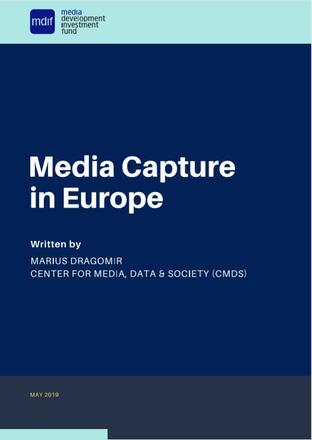
Being the term ‘media capture’ relatively new, the study tries to conceptualise this widespread issue, starting from the definition proposed by Mungiu-Pippidi - “a situation in which the media have not succeeded in becoming autonomous in manifesting a will of their own, nor able to exercise their main function, notably of informing people (...)”- and identifying, then, a more practical use of the concept.
Furthermore, following Corduneanu-Huci and Hamilton’s approach, the study presents a useful model to determine the intensity of media capture in a given national context. Considering this phenomenon as “a process with its own intensity scale consisting of higher or lower levels of control”, it proposes 4 components that can be used as a tool to analyse the jeopardy of a particular situation. Still, the research presents these components using several examples, taken, in particular, from Hungary and Czech Republic as representative case studies.
- Regulatory Capture: it refers to the government control of national regulators, divided in broadcast and competition authorities; for example, the author reports the case of the Czech antitrust watchdog (UOHS) led by Petr Rafaj.
- Control of Public Service Media: this generally depends, at least in Eastern Europe, on the failed process of reform of former state media into public service media; in Hungary, for example, “the public broadcaster MTVA operates as a government body rather than an independent institution”.
- Use of State financing as a control tool: as for state funding, there are four main categories of financial strategies used to control media. Namely: i) Public funding for state-administered media; ii) State advertising (“the most insidious form of government funding in the media”); iii) State subsidies; iv) Market-disruption measures.
- Ownership takeover: during the past decade the media market has been impacted by a new class of media owners, predominantly domestic, closely linked with political parties or interest groups. Hungary, according to the document, best illustrates this collusion: as reported by the author, “since 2010, a total of 400 media outlets were taken over by a group of oligarchs supportive of Prime Minister Orbán and his party, Fidesz”.
In this context, the report highlights a number of interconnected factors that unveil the complex and multifaceted nature of media capture:
- the failed reform of the Public Service Media provoked the proliferation of new media financed through loans from state-controlled banks or capital from unknown sources;
- these new emerging media have expanded rapidly into media cartels dominated by oligarchs;
- the phenomenon is having the most disruptive effects in transitional areas, such as Eastern Europe;
- the involvement of the private sector distinguishes media capture from other forms of government control of the media;
- media capture has a crossboarding nature, and seems to be related to the rise of right-wing parties.
Concluding, the author underlines the difficulties in finding policy solutions, “as policymaking and regulation are part of the problem (they are a cog in the media capture wheel)”. “Hence”, he states, “the only solution lies in direct intervention: renewed and much larger investments in independent news outlets, with a focus on new, more disruptive forms and formats of critical journalism able to better reach and engage large audiences”.
Tags: Media capture Freedom of expression Media freedom Media ownership Media pluralism Hungary Czech RepublicThe content of this article can be used according to the terms of Creative Commons: Attribution-NonCommercial 4.0 International (CC BY-NC 4.0) . To do so use the the wording "this article was originally published on the Resource Centre on Media Freedom in Europe" including a direct active link to the original article page.

